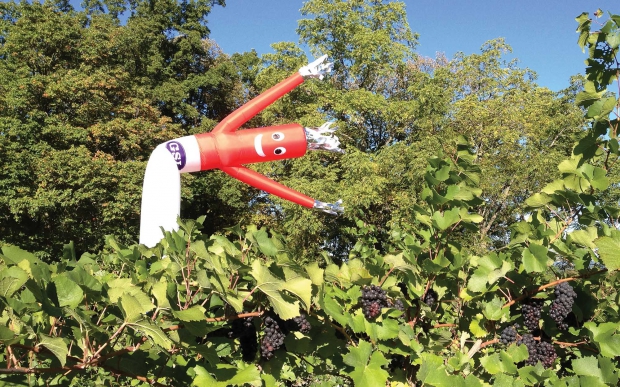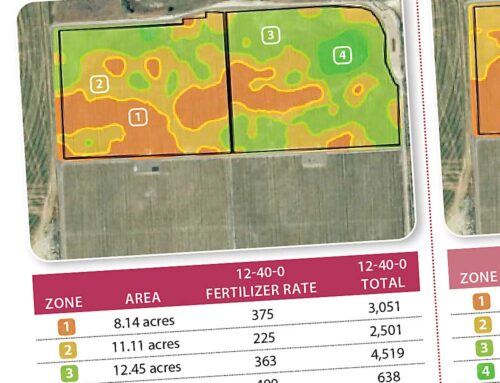
Air dancers appeared in vineyards in Michigan and New York last summer, in a test to see how well they could do at scaring away birds that feed on ripening grapes. (Courtesy Heidi Henrichs, Cornell University)
There’s a line in the movie Fiddler on the Roof where a beggar, given a small coin, complains: “Just because you’re having a bad year doesn’t mean I should suffer.”
Birds are like that, and they’re quite successful at getting the proper coin.
Birds appear to eat about the same amount of fruit each year, but the amount of damage is perceived differently when the crop is short.
Dr. Catherine Lindell, an associate professor in the Department of Zoology at Michigan State University, observed: “Bird management is less of a priority for growers in years of good fruit production.”
Lindell is heading a project, funded by a $2 million Specialty Crop Research Initiative grant, to document the economic impact of birds on fruit crops and to look for cost-effective bird management strategies, preferably those that don’t offend people who like birds.
The three-year project involves researchers from Oregon State University, Washington State University, Cornell University, the U.S. Department of Agriculture National Wildlife Research Center in Colorado, and Trinity Western University in Langley, British Columbia, Canada.
When the project began collecting data in 2012, figures were alarming. Bird damage levels reached 28 percent in cherries in New York and more than 10 percent in Michigan in both cherries and grapes.
Now it appears the size of the fruit crop goes up and down while bird consumption of fruit may be relatively stable. When crop size in the East was greatly reduced by the freezes of 2012, birds got a high percentage of what remained. In 2013, eastern fruit crops were large and damage to cherries was less than 5 percent, Lindell said.
Air dancers
In 2013, the project got favorable publicity, started off by an article in the Wall Street Journal. The article was about air dancers.
“We’re trying to find novel techniques as well as evaluating those that have been used over the years,” said Paul Curtis, associate professor of natural resources at Cornell University and a researcher in the bird damage project. “I’d heard that Scarey Men were used in aquaculture in Mississippi to protect fish from predatory birds, so I said, why not? We piloted them in blueberries and grapes.”
The flailing arms of these 20-foot-tall inflatable tube men, known as air dancers and commonly used to attract customers to car dealerships, work as moving scarecrows.
The big wind socks are inflated by a fan at the base, which runs continuously, keeping the air dancer erect but not so rigid as to be unable to flex and move. Curtis tried them at several locations, some close to electrical outlets that could be served by extension cords. Other, more remote locations required electrical generators.
They were turned on each morning and turned off at night. “They worked pretty well, even when overnight rains soaked them,” Curtis said. “They didn’t tend to get tangled up or have problems in the wind.”
The landowners liked them, he said, and one vineyard had a naming contest. The winning name was Mr. Pinot.
One landowner’s dog never got used to the Scarey Man, leading Curtis to wonder whether they may be useful in scaring off deer.
The air dancers were used at ten sites in Michigan as well as the four in New York State.
Deterrents
Lindell gave a report on the work at the Northwest Michigan Orchard and Vineyard Show in Traverse City, Michigan, in January.
The studies are being conducted in cherry orchards, blueberry plantations, wine grape vineyards, and Honeycrisp apple orchards.
“We conducted pilot tests of several bird management strategies in 2013,” she said. “Our primary objective was to determine which strategies warrant larger-scale, well-replicated studies next field season.
“We tested the value of using multiple deterrents and changing deterrent locations. Deterrents tested include audio boxes emitting bird distress and alarm calls, live and artificial predatory birds, inflatable air dancers, netting, and chemical sprays.”
Birds tend to get used to some deterrent devices. So these need to be moved about 15 yards every couple of days. Last year, they tested the noise boxes that emanate distress calls or sounds made by predators. They also tested Tyvek kites that have images of predatory raptor birds, like hawks and falcons.
The kites were suspended on poles and occasionally got wrapped up around them. “They were pretty well worn out by the end of the season,” Lindell said. “We used a lot of duct tape.”
They also did preliminary investigation of the effectiveness of American kestrels. “They’re pretty popular in the Pacific Northwest,” she said. “They’re easily attracted to nest boxes where they lay eggs and raise their young.”
In a diet study conducted by graduate student Megan Shave, based on camera recordings of parent birds arriving at boxes with prey, they found some bird remains, but mostly voles and chipmunks, grasshoppers, crickets, and beetles, she said. “They’re a low-maintenance, low-cost addition to an orchard,” she said. The boxes need to be cleaned once a year.
One part of the project included a study of what people are willing to pay for fruit depending on how the fruit is produced.
“Preliminary results show consumers are willing to pay more for fruit produced using falconry or nest boxes to attract bird predators,” according to a project report. “They will not pay as much for fruit produced using shotguns or artificial grape flavoring spray as deterrents.”
In the future, unmanned aerial vehicles—drones—may find a place as bird deterrents as well, she said, but they are definitely not ready for prime time.
Larger falcons are quite effective in scaring off birds, and drones might work as well without the labor and management cost that goes with live predatory birds.
One other aspect of bird damage will be studied this year, and that is the effect of fruit crop location. They are probably places that are so favorable for wild bird populations it would be foolish to locate fruit production there.
More information can be found at the Web site http://birddamagetofruit crops.info. •






Nice article but where is the HARD evidence, like the reduction in damaged fruit between untreated orchards and treated orchards? The world has been using many forms of scare crows for mellenia
Where can I buy the inflatable Mr. Pinot?